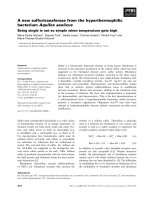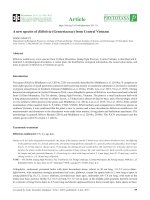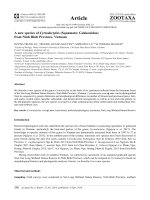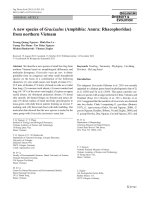Aethionema aytachii (Brassicaceae): A new species from central Anatolia, Turkey
Bạn đang xem bản rút gọn của tài liệu. Xem và tải ngay bản đầy đủ của tài liệu tại đây (1.96 MB, 10 trang )
Turkish Journal of Botany
/>
Research Article
Turk J Bot
(2021) 45: 563-572
© TÜBİTAK
doi: 10.3906/bot-2104-31
Aethionema aytachii (Brassicaceae): A new species from central Anatolia, Turkey
Kuddisi ERTUĞRUL1,*
, Ergin HAMZAOĞLU2 , Hakkı DEMİRELMA1 , Tuna UYSAL1 , Meryem BOZKURT1
Emrah ŞİRİN1 , Burcu YILMAZ ÇITAK1 , Ihsan A. Al-SHEHBAZ3
1Department of Biology, Faculty of Science, Selỗuk University, Konya, Turkey
2Department of Mathematics and Science Education, Gazi Faculty of Education, Gazi University, Ankara, Turkey
3Missouri Botanical Garden, 4344 Shaw Boulevard., St. Louis, Missouri, 63110, USA
,
Accepted/Published Online: 22.06.2021
Final Version: 30.12.2021
Received: 20.04.2021
Abstract: Aethionema aytachii Ertuğrul & Hamzaoğlu, a new species from central Anatolia that grows on marly hills in the Ayaş district
of Ankara Province (Turkey), is described and its relationships and distinguishing characters from the closest relative A. dumanii are
discussed. The shape of pollen grains of A. aytachii is tricolpate, and its seed-coat sculpture is verrucate. Sequence data of the internal
transcribed spacer region (ITS) of the new species was used to determine about its phylogenetic relation within Aethionema.
Key words: Cruciferae, internal transcribed spacer region (ITS), phylogeny, pollen and seed micromorphology
1. Introduction
Brassicaceae is a large family of some 345 genera and
4020 species (Al-Shehbaz compilation) distributed on all
continents except Antarctica. It is centered primarily in
the temperate areas, especially in the Mediterranean
basin and in south-western and central Asia (Kandemir et
al., 2017).
Aethionema W.T.Aiton is a taxonomically complex
genus of some 57 species; the center of its greatest
diversity is Turkey and less so in neighboring countries
(Iran, Caucasian republics, Greece), but with individual
species distributed eastward as far as Kazakhstan and
westward into Spain and Morocco (Hedge, 1965;
Moazzeni et al., 2016; authors’ compilation). The genus is
sister to the rest of the family and was placed in a
unigeneric tribe Aethionemeae (Al-Shehbaz, 2012). The
source of its complexity is the presence of few macro
morphological characters (e.g., fruit and leaf characters)
that can be used in the delimitation of species. Aethionema
was previously known to be represented in Turkey by 40
species (Ertuğrul, 2012), but several new species have
since been described, and it is currently estimated to
include as many as 53 species in the country (Karabacak
et al, 2013; Yıldırımlı and Klỗ, 2016; Kandemir et al.,
2017; Yldrml and Klỗ, 2019).
During ongoing systematic and phylogenetic studies
on the genus by one of us (K.E.), independent extensive
fieldwork by the first two authors resulted in the
collection of numerous samples of many species. Among
these were some specimens that did not belong to any of
the known species. As a result of comprehensive studies,
it was concluded that these represent a new species
hereafter recognized as A. aytachii Ertuğrul & Hamzaoğlu.
2. Materials and methods
Some Aethionema specimens were collected from Aysantı
Pass, in the Ayaş district of Ankara Province, by the first
and second authors in 2019. These were compared
* Correspondence:
against the treatments of the genus in the Flora of Turkey
and the East Aegean Islands (Hedge, 1965; Davis et al.,
1988; Adıgüzel 2000) and other related floras and
checklists (e.g., Chaytor & Aktyroyd, 1993; Hedge, 1968;
Busch, 1939; Ertuğrul, 2012) and the recently described
new species (Yldrml and Klỗ, 2016, 2018, 2019), as
well as the study of Aethionema collections in the herbaria
ANK, E, G, GAZI, HUB, K, and KNYA (acronyms follow
Thiers, 2021). Our specimens were critically compared
with A. armenum Boiss. And A. dumanii Vural & Adıgüzel,
the two species that appeared most closely related to it.
For molecular phylogenetic studies, we used silica gel
dried leaves collected from the type localities of A.
aytachii, A. dumanii, A. turcicum H.Duman & Aytaỗ, A.
grandiflorum Boiss. & Hohen, and A. armenum. Total
genomic DNA extraction followed the 2X CTAB method of
Doyle & Doyle (1987) as modified in Soltis et al. (1991)
and Cullings (1992). Sequencing and amplification of both
DNA strands was performed using ITS1 and ITS4 primers
(White et al., 1990). Direct sequencing of amplified DNA
was performed using the Big Dye Terminator Cycle
Sequencing v.3.1 (Macrogen, Netherlands) software
program, following the manufacturer instructions. The
complete ITS gene sequences of nine Aethionema taxa and
two Noccaea Moench. Species (as the out-group) were
used. Sequences of A. armenum and the out-group were
taken from GenBank (National Center for Biotechnology
Information), but all other samples in this study are new
(Table 1). Editing of the nucleotide sequences and visual
alignments were performed using Bioedit v.7.0.5.3 (Hall,
1999). Parsimony analysis was conducted using PAUP
v.4.0b10 (Swofford, 2002). Bootstrap (BS) analyses
(Felsenstein, 1985) were conducted with 1000 replicates
of the heuristic search using the default options. For the
strict consensus tree, the retention index (RI) and
consistency index (CI) were given, with the exclusion of
the uninformative characters. We used MrBayes 3.2
(Ronquist et al., 2012) to perform the Bayesian
563
ERTUĞRUL et al. / Turk J Bot
Table 1. Voucher specimens for the ITS study.
Taxa
Collection number
GenBank
Author, year
Aethionema aytachii
K.Ertuğrul 5757
MW791188
Uysal et al., 2021
A. turcicum
K.Ertuğrul 5754
MW791189
Uysal et al., 2021
A. dumanii
K.Ertuğrul 5755
MW791190
Uysal et al., 2021
A. armenum
K.Ertuğrul 5756
MW791191
Uysal et al., 2021
A. armenum
T.Uysal 4096
MW791192
Uysal et al., 2021
A. grandiflorum
K.Ertuğrul 5815
MW791193
Uysal et al., 2021
A. armenum
MT799720
Bozkurt et al., 2020
Noccaea iberidea
MN871751
Özüdoğru et al., 2019
N. oppositifolia
MG944851
Özüdoğru et al., 2018
phylogenetic analyses. In the Bayesian analyses, random
starting trees were used, which were run for 1 × 10 5
generations, comprising 2 independent runs that
consisted of four metropolis-coupled chains. Tracer
v.1.5.0 software was used to analyze the trace files created
by the Bayesian Markov chain Monte Carlo studies
(Rambaut and Drummond, 2007) and, after checking
them for convergence, the first 1000 samples (20%) were
discarded as burn-in. FigTree v1.4.0 software
( was used as
the graphic viewer of the phylogenetic tree.
Pollen was obtained from herbarium specimens and
prepared following Wodehouse (1935). The pollen slides
were observed using a Leica DM 1000 light microscope
(LM) (Leica Microsystems, Wetzlar, Germany), and
measured using Kameram 21 software (Argenit, Istanbul,
Turkey). The measurements were based on at least 30 or
more pollen grains from each specimen. The seeds were
first investigated using a Leica Z6 Apo 16 stereoscopic
microscope, and at least 15 mature seeds were measured.
For the scanning electron microscopy (SEM) analyses,
mature seeds or dried non-acetolysed pollen were placed
directly onto aluminium stubs and coated with gold using
a sputter-coater. They were photographed using a Zeiss
Evo LS 10 SEM (Carl Zeiss NTS GmbH, Oberkochen,
Germany). For pollen and seed terminology, Punt et al.
(2007) and Pınar et al. (2007) were followed, respectively.
3. Results
3.1 Aethionema aytachii Ertuğrul & Hamzaoğlu sp.
Nov.
Plants and dehiscent fruit of Aethionema aytachii and
indehiscent fruit of A. aytachii are shown in Figures 1 and
2A, 2B.
Type: TURKEY. B4 Ankara: Ayaş, around Aysantı Pass,
marly hills along roadsides, 1190 m, 31.v.2019, K.Ertuğrul
5757 & T.Körüklü (Holotype KNYA; Isotypes GAZI, ANK).
Paratypes: TURKEY. B4 Ankara: Ayaş, Aysantı Pass,
marly hills on roadside, 1190–1250 m, 14.vi.2019,
H.Demirelma 3371 (KNYA); ibid.18.v.2019, E.Hamzaoğlu
7549 (KNYA); ibid. 1.viii.1985, Z. Aytaỗ 1967 (GAZI).
Diagnosis: Aethionema aytachii resembles A. dumanii
in having densely flowered racemes that elongate in fruit,
and from which it differs by the densely (vs. loosely)
564
overlapping stem leaves, heterocarpic (vs. homocarpic)
fruits, inner filaments 2–2.5 (vs. ca. 1.7) mm long, fruiting
pedicels 1.5–3.5 (vs. 6–7) mm long, and styles exerted
from (vs. included in) the apical fruit sinus. From A.
armenum, A. aytachii differs by its densely (vs. loosely)
overlapping stem leaves, petals 5.8–7 (vs. 4–4.2) mm long,
heterocarpic (vs. homocarpic) fruits, inner filaments
dilated (vs. slender) at base, and style clearly exceeding
(vs. equalling or shorter) than the apical fruit sinus (Table
2).
Description: Perennial, stem ascending, 3–9 cm tall,
branched. Leaves alternate, falcate, margins involute,
sessile, rounded at base, subapiculate or acute at apex;
lowermost leaves ovate-oblong, 4–7 × 0.5–1.5 mm; stem
leaves oblong to narrowly so, 4–6 × 1–2 mm. Raceme 10–
20-flowered, compact, elongated in fruit. Pedicel 1.5–2.1
mm long in flowers, 1.5–3.5 mm long in fruit, erect at base,
sometimes recurved distally. Sepals saccate, green with a
white scarious margin, 2–2.5 × 0.8–1.5 mm. Petals 5.8–7 ×
1.5–2.5 mm, pink, 3-veined at base, claw not distinct. Inner
(median) filaments free, dilated at base, 2–2.5 mm long,
outer (lateral) filaments 1.5–1.8 mm long; anthers
triangular to oblong, 0.5–0.6 mm long, apex obtuse in
inner filaments, acute in outer ones. Fruit lax, cordate at
base, heterocarpic; indehiscent fruit orbicular, 4–5 × 5–
5.5 mm, unilocular, 1-ovuled, septum 3–4 × 1–1.5 mm,
wings 2–2.1 mm wide, irregularly crenate–dentate, sinus
0.5–1 mm deep, style 1–1.5 mm long; dehiscent fruit
obovate, 6.5–7.1 × 5–5.1 mm, bilocular, 1- or 2- ovuled per
locule, septum 4–5.5 × 1.5–2 mm, wings 1.5–2.1 mm wide,
undulate along margins, sinus ca. 1 mm deep, style 0.5–1
mm long. Seeds (2–) 3 (–4), ovate, light-brown, 1.71–1.31
× 0.70–0.86 mm in indehiscent fruits, 1.3–1.4 × 1.3–1.4
mm in dehiscent fruits.
3.2. Etymology
The species was dedicated to Prof. Dr. Zeki AYTAÇ
(25.01.1956), a Turkish botanist who has provided many
contributions to plant taxonomy. The Turkish name of this
new species was suggested as ‘Ayaşkayagülü’ (Menemen
et al., 2016).
3.3. Molecular analyses and results
Seven accessions of closely related Aethionema species
and two out-group Noccaea species were used for
phylogenetic comparison and reconstruction. The total
ERTUĞRUL et al. / Turk J Bot
Figure 1. Plants of Aethionema aytachii.
Figure 2. A. Dehiscent fruit of Aethionema aytachii, B. indehiscent fruit of A. aytachii, and C. Fruit of A. dumanii.
565
ERTUĞRUL et al. / Turk J Bot
length of studied DNA segments was 601 bp, 123 of which
were parsimony informative. The topologies obtained
from both the parsimony and Bayesian inference analyses
were identical, and the combined tree is shown in Figure
3. The constructed tree shows higher resolution in the
Bayesian than parsimony values. The Aethionema taxa
grouped into 3 main clades in the concatenated tree (PP:
1, BS: 100; Figure 3). The first clade comprised A. aytachii
sister to A. dumanii and together sister to A. turcicum. The
second clade included three different populations of A.
armenum. The third clade was A. grandiflorum. Clearly, A.
aytachii is closest to A. dumanii and A. turcicum than to A.
armenum.
3.4. Pollen morphology
The pollen grains of Aethionema aytachii, A. armenum, and
A. dumanii were radially symmetrical, isopolar, and
tricolpate, as in about 97% of the Brassicaceae. However,
the pollen grains of A. aytachii were sometimes (4%)
syncolpate. Pollen shape was oblate in A. aytachii and A.
armenum and subprolate in A. dumanii. The pollen size
showed some differences among three taxa in the polar
(P) and equatorial (E) views. In A. aytachii, it was P: 12.95
± 1.16 µm, E: 19.31 ± 1.15 µm, while in A. armenum, it was
P: 11.24 ± 0.76 µm, E: 16.51 ± 2.44 µm, and in A. dumanii
P: 16.78 ± 1.56 µm, E: 13.71 ± 1.24 µm. The outline of the
pollen grains was elliptic in equatorial view and triangular
Table 2. Morphological comparison of Aethionema aytachii, A. dumanii, and A. armenum.
A. dumanii
Species/characters A. aytachii
(Vural and Adıgüzel, 1995)
Stem
Ascending
Erect-ascending
A. armenum
(Hedge, 1965)
Erect-ascending
Stem (cm)
3–9.5
10–20
6–21
Stem leaves
Densely spread
Loosely spread
Loosely spread
Leaves shape
Oblong-ovate to narrowly oblong
Oblong-linear
Petals
Pink, 5.8–7 × 1.5–2.5 mm
Pink, ca. 6 × 2.5 mm
Fruits
Heterocarpic
Homocarpic
Oblong-linear
Pink or white, 4–4.2 × 1.3–2
mm
Homocarpic
Inner filaments
Dilated at base, 2–2.5 mm
Dilated at base, ca. 1.7 mm
Not dilated at base, 1.5–2 mm
Fruiting pedicels
Erect, rarely recurved, 1,5–3.5 mm
Indehiscent fruits orbicular, 4–5 × 5–5.5 mm, wings
2–2.1 mm and irregularly crenate–dentate, sinus 1
mm, style 0.5–1 mm long; dehiscent fruits obovate,
6.5–7.1 × 5–5.1 mm, wings 1.5–2.1 mm and
undulate, sinus 0.5-1 mm, style 1–1.5 mm long
Clearly exceeds sinus
Erect, (5–) 6–7- (–8) mm
Orbicular, 6–7.5 (–9) × 7–9,
wings 3–4 mm and undulate,
irregular crenate–dentate, sinus
1.5–2 mm, style 1.5–2 mm
long
As long as sinus
Erect to recurved, 3–4.8 mm
Ovate to obovate, 4–5.5 (–7) ×
3.5–4 (–5), wings 1–1.5 mm
and crenate or entire, sinus
0.5–1 (–1.5), style ca. 0.5 mm
long
As long as or shorter than sinus
Siliculae
Style
Figure 3. ITS majority rule consensus tree from Bayesian inference and Parsimony analysis, and numbers depict posterior
probabilities and bootstrap values. (CI = 0.944; RI = 0.946; HI = 0.056).
566
ERTUĞRUL et al. / Turk J Bot
in polar view. The colpus was long and sunken, margins
distinct, regular, and ends ovate. The sculpture of the
exine exhibited reticulate ornamentation. The muri
shapes varied among the species, and that of A. aytachii
was larger than the others (Figure 4, Table 3). Detailed
pollen morphological characters of the examined species
are given in Table 3.
3.5. Seed morphology
The seeds were ovate and light-brown in all species. In
Aethionema aytachii the seed size from the indehiscent
fruit was 1.17–1.31 × 0.70–0.86 mm in those from
dehiscent fruit was 1.4–1.3 × 0.9–0.85 mm, while it was
1.19–1.31 × 0.64–0.90 mm in A. armenum and 1.23–1.52 ×
0.73–0.96 mm in A. dumanii. The seed shape in A. aytachii
and A. armenum was ovate, while those of A. dumanii were
broadly oblong-ovate) (Table 4). The ornamentation of
seeds surface in A. aytachii was verrucate, reticulateverrucate in A. armenum, and reticulate in A. dumanii
(Figures 5 and 6). The epidermal cells on the seeds were
Figure 4. SEM micrographs of the pollen grains of Aethionema aytachii (a, b), A. armenum (c, d), and A. dumanii (e, f). a, c, e General
view, and b,d,f exine sculpturing.
567
ERTUĞRUL et al. / Turk J Bot
Table 3. Pollen morphological data of Aethionema aytachii, A. armenum, and A. dumanii (values in µm, mean ± standard deviation).
Species/pollen characters
A. aytachii
A. armenum
A. dumanii
Min-max
11.88–14.19
10.39–11.86
15.2–19.2
Mean
12.95 ± 1.16
11.24 ± 0.76
16.78 ± 1.56
Min-max
18.06–20.32
14.55–19.26
11.54–15.41
Mean
19.31 ± 1.15
16.51 ± 2.44
13.71 ± 1.24
Pollen shape
Oblate
Oblate
Subprolate
Aperture type
96% tricolpate and 4% syncolpate
Only tricolpate
Only tricolpate
Sculpture
Reticulate
Reticulate
Reticulate
Polar axes
Equatorial axes
1.63 ± 0.34
1.04 ± 0.19
0.59 ± 0.07
Colpus length (Clg)
19.1 ± 0.67
15.07 ± 1.12
14.73 ± 1.04
Colpus width (Clt)
2.62 ± 0.3
1.99 ± 0.17
1.38 ± 0.03
Exine thickness
1.08 ± 0.17
0.83 ± 0.14
0.93 ± 0.07
Intine thickness
0.63 ± 0.17
0.41 ± 0.01
0.56 ± 0.06
Apocolpium
2.01 ± 0.2
2.77 ± 0.83
2.13 ± 0.08
Muri
Colpus
Table 4. Seed morphological data of Aethionema aytachii, A. armenum, and A. dumanii (values in mm).
Species/seed characters
A. aytachii (indehiscent fruit)
A. aytachii (dehiscent fruit)
A. armenum
A. dumanii
Seed length
1.17–1.31
1.3–1.4
1.19–1.31
1.23–1.52
Seed width
0.70–0.86
0.85–0.9
0.64–0.90
0.73–0.96
Seed shape
ovate
ovate
ovate
Broadly ovate-oblong
Seed color
Light brown
Light brown
Light brown
Light brown
Seed surface
Verrucate
Verrucate
Reticulate-verrucate
Reticulate
oval in shape, with striate ornamentation in A. aytachii
and A. armenum.
3.6. Distribution, habitat, and ecology
Aethionema aytachii grows on marly hills around Aysantı
Pass in the Ayaş district of Ankara Province at altitudes of
1190–1250 m, and it is associated with A. dumanii, A.
turcicum, Astragalus densifolius Torr. subsp. ayashensis
Aytaỗ & Ekim, and Campanula damboldtiana P.H.Davis &
Sorger.
This region is one of the well-conserved marly steppe
areas near Ankara, and it is part of the Irano-Turanian
floristic region (Figure 7).
3.7. Conservation status
Aethionema aytachii is a locally endemic species and is
known only from its type locality (Figure 7). The species
is rare in the field, and its extent of occurrence (EOO) and
area of occupancy (AOO) are less than 1 km². Due to
agricultural activities, such as hobby gardening and road
construction in this area, the new species is considered as
“critically endangered” CR B1ab(I,ii) + 2ab(I,ii) (IUCN,
2017).
4. Discussion
Aethionema aytachii most closely resembles A. dumanii in
having subapiculate or acute leaves, sepal size, pink
petals, and dilation at the base of the inner filaments, but
it differs by having dense stem leaves, heterocarpic fruit
(Figure 2), fruiting pedicel measurements, and style/sinus
568
ratio. According to Pınar et al. (2007), the four seedornamentation types in Aethionema are reticulate,
ruminate, reticulate-verrucate, and verrucate. Using this
seed-sculpture terminology, the seeds of A. aytachii are
verrucate, and they are contrast reticulate-verrucate in A.
armenum and reticulate of A. dumanii. The palynological
data showed rather minor differences that need not be
emphasized for the separation of these three species.
Mohammedin et al. (2017) showed some correlation
between morphological characters (e.g., ovate vs. linear
leaf shape, fruit type dehiscent vs. heterocarpic, presence
vs. absence of spines, and plant duration annual vs.
perennial) and molecular database on plastome coding
regions and nuclear rDNA genes in the genus Aethionema.
Their data showed that A. dumanii and A. turcicum fell in
the same clade, and our results fully support that.
According to the literature, it has been emphasized that in
several species of Aethionema, both dehiscent and
indehiscent fruits are developed (Appel and Al-Shehbaz,
2003), and heteromorphism is of independent origin
(Lenser et al., 2016; Mohammedin et al., 2017). They
speculated that there is a correlation between the annual
habit and heterocarpy, but such hypothesis needs further
testing because heterocarpy is found in four perennial
species, including A. aytachii, A. thomasianum J.Gay (Italy,
Spain), A. rhodopaeum D.Pavlova (Bulgaria), and the
widespread A. saxatile (L.) W.T.Aiton (Turkey westward
into S, C, and SW Europe and NW Africa). From the last
ERTUĞRUL et al. / Turk J Bot
Figure 5. LM micrographs of the Aethionema species a. A. aytachii (seeds of indehiscent fruit), b. A. aytachii (seeds of dehiscent
fruit), c. A. armenum, and d. A. dumanii.
three species, A. aytachii is readily distinguished by having
much narrower leaves with length/width ratio of at least
4–6:1 (vs. 1–2.5:1). Heterocarpy was suggested to be a
conservation strategy against risks arising from
environmental conditions because the production of
different morphs gives the plants some flexibility in
response to environmental stimuli (Imbert, 2002; Lenser
et al., 2016; Bhattacharya et al., 2019).
In conclusion, our study demonstrates that
Aethionema aytachii is most closely related to A. dumanii
from which it is readily distinguished by the production of
heterocarpic vs. homocarpic fruits.
Examined specimens are as follows.
Aethionema armenum: Ayaş, around Aysantı Pass,
marly hills to the right and left of the road, 1190 m,
31.v.2019, K. Ertuğrul 5756 & T. Körüklü (KNYA), Aysantı
Pass, marly hills to the right of the road, 1190–1250 m,
14.vi.2019, H. Demirelma 3373, 3374 (KNYA).
Aethionema dumanii: Ayaş, around Aysantı Pass, marly
hills to the right and left of the road, 1190 m, 31.v.2019, K.
Ertuğrul 5755 (KNYA) Aysantı Pass, marly hills to the
right of the road, 1190–1250 m, 14.vi.2019, H. Demirelma
3370 (KNYA), Eskişehir, Polatlı to Sivrihisar, 25. Km, 870
m, 10.vii.1993, H. Duman 5011 (holo. GAZI! Iso. ANK!)
Acknowledgments
The authors would like to thank TÜBİTAK (project
number: 118Z995) for its financial support of this
research. We also thank Tuğrul KÖRÜKLÜ for his
contributions in the first field study.
569
ERTUĞRUL et al. / Turk J Bot
Figure 6. SEM micrographs of the seeds of Aethionema aytachii (indehiscent fruit) (a–c), A. aytachii (dehiscent fruit) (d–f), A.
armenum (g–i), and A. dumanii (j–l). a, d, g, and j. General view, b, c, e, f, h, i, k, and l. Surface ornamentation.
570
ERTUĞRUL et al. / Turk J Bot
Figure 7. Distribution map of Aethionema dumanii (⧫), A. armenum (), and A. aytachii ().
References
Adıgüzel N (2000). Aethionema W.T. Aiton. — In: Güner A., Özhatay
N., Ekim T. & Başer K.H.C. (eds.), Flora of Turkey and the East
Aegean Islands, vol. 11: 31–34. Edinburgh University Press,
Edinburgh.
Al-Shehbaz IA (2012). A generic and tribal synopsis of the
Brassicaeae (Cruciferae). — Taxon 61: 931–954.
Appel O, Al-Shehbaz IA (2003). CruciferA. In: Kubitzki K, Bayer C
(editors). The families and genera of vascular plants 5.
Springer, Berlin & Heidelberg, pp. 75–174. doi: 10.1007/9783-662-07255-4_17
Bhattacharya S, Sperber K, Özüdoğru B, Leubner-Metzger G,
Mummenhof K (2019). Naturally-primed life strategy plasticity
of dimorphic Aethionema arabicum facilitates optimal habitat
colonization. Scientific Reports 9: 1-11.
Busch NA (1939). Aethionema. In: Komarov VL (ed.), Fl. SSR. Vol. 8:
552–568. Moscow and Leningrad.
Chaytor AO, Akeroyd JE (1993). Aethionema. In: Tutin TG et al. (eds.),
Flora Europaea. Ed. 2, Vol. 1: 388–390. Cambridge Univeristy
Press.
Cullings KW (1992). Design and testing of a plant-specific PCR
primer for ecological and evolutionary studies. Molecular
Ecology 1: 233–240.
Davis PH, Mill RR, Tan K (1988). Aethionema W.T. Aiton. — In: Davis
PH, Mill RR & Tan K (eds.), Flora of Turkey and the East Aegean
Islands, vol. 10: 35–39. Edinburgh University Press, Edinburgh.
Doyle JJ, Doyle JL (1987). A rapid DNA isolation procedure for small
quantities of fresh leaf tissue. Phytochemical Bulletin,
Botanical Society of America 19: 11–15.
Ertuğrul K (2012). Aethionema W.T. Aiton. — In: Güner A.,Aslan S,
Ekim T, Vural M , Babaỗ MT (eds.), [Turkeys list of plants
(vascular plants)]: 246248. Nezahat Gửkyiit Botanik Bahỗesi
ve Flora Aratrmalar Dernei Yayn, Istanbul. [In Turkish].
Felsenstein J (1985). Confidence limits on phylogenies: An approach
using the bootstrap. Evolution 39: 783–791.
Hall TA (1999). Bio Edit: A user-friendly biological sequence
alignment editor and analysis program for windows
95/98/NT. Nucleic Acid Symposium 41: 95–98.
Hedge IC (1965). Aethionema R. Br. In: Davis PH (editor). Flora of
Turkey and the East Aegean Islands 1. [Edinburgh] University
Press, Edinburgh, pp. 314–330.
Hedge IC (1968). Aethionema R. Br. & Moriera Boiss. In: Hedge IC,
Rechinger KH (editors). Flora Iranica 57. Academische Drucku.
Verlagsanstalt, Graz, pp. 100–110, 354.
IUCN (2017). IUCN Standards and Petitions Subcommittee.
Guidelines for Using the IUCN Red List Categories and Criteria.
Version 10. prepared by the Standards and Petitions
Subcommittee.
Imbert E (2002). Ecological consequences and ontogeny of seed
heteromorphism. Perspect Plant Ecology, Evolution, and
Systematics 5: 1336.
Kandemir A, Aytaỗ Z, Fine AY (2017). Aethionema erzincanum
(Brassicaceae), a new species from Turkey. Annales Botanici
Fennici 54 (1–3): 1–5.
Karabacak O, Öztürk M, Duran A (2013). Aethionema anatolica
(Brassicaceae), a new species from south Anatolia, Turkey.
Annales Botanici Fennici 50 (3) 183–186.
Lenser T, Graeber K, Çevik ƯS, Adigüzel N, Dưnmez AA et al. (2016).
Developmental control and plasticity of fruit and seed
dimorphism in Aethionema arabicum. Plant Physiology 172:
16911707.
Menemen Y, Aytaỗ Z, Kandemir A (2016). Tỹrkỗe Bilimsel Bitki
Adlandrma Yửnergesi. Babahỗe Bilim Dergisi 3 (3): 1–3 (in
Turkish).
571
ERTUĞRUL et al. / Turk J Bot
Moazzeni H, Al-Shehbaz IA, German DA, Assadi M, Mueller J et al.
(2018). A taxonomic revision of the genus Aethionema sl
(Brassicaceae) in Iran. Phytotaxa 356 (4): 241–266.
Mohammadin S, Peterse K, van de Kerke SJ, Chatrou LW, Dönmez AA
et al. (2017). Anatolian origins and diversification of
Aethionema, the sister lineage of the core Brassicaceae.
American Journal of Botany 104 (7): 1042–1054.
Pınar NM, Adıgüzel N, Geven F (2007). Seed coat macrosculpturing
in some Turkish Aethionema R. Br. (Brassicaceae). Pakistan
Journal of Botany 39 (4): 1025–1036.
Punt W, Hoen P, Blackmore S, Nilsson S, Le Thomas A (2007).
Glossary of pollen and spore terminology. Review of
Palaeobotany
and
Palynology
143:
1–81.
doi:
10.1016/j.revpalbo.2006.06.008
Rambaut A, Drummond AJ (2007). Tracer v1.5. Available from:
http:// tree.bio.ed.ac.uk/software/tracer.
Ronquist F, Teslenko M, van der Mark P, Ayres DL, Darling AL et al.
(2012). MRBAYES 3.2: Efficient Bayesian phylogenetic
inference and model selection across a large model space.
Systematic Biology 61: 539–542.
Soltis DE, Collier TG, Edgerton ML (1991). The Heuchera group
(Saxifragaceae): Evidence for chloroplast transfer and
paraphyly. American Journal of Botany 78: 1091–1112.
Swofford DL (2002). PAUP Version 4.0 b10. Phylogenetic analysis
using parsimony (and other methods). Sinauer, Sunderland.
572
Thiers B (2021). Index Herbariorum: A global directory of public
herbaria
and
associated
staff.
Available
from:
http://sweetgum. nybg.org/ih/ (accessed 02.ii.2021)
Vural M, Adıgüzel N (1995). A New Species from Central Anatolia –
Aethionema dumanii (Brassicaceae). Turkish Journal of Botany
19: 481–483.
White TJ, Bruns T, Lee S, Taylor J (1990). Amplification and direct
sequencing of fungal ribosomal RNA genes for phylogenetics.
In: Innis MA, Gelfand DH, Sninsky JJ, White TJ (editors). PCR
Protocols: A guide to methods and applications. pp. 315–322.
Academic Press, New York.
Wodehouse RP (1935). Pollen Grains. New York, NY, USA: McGrawHill Press.
Yldrml , Klỗ ệ (2016). New infrageneric taxa and species of
Aethionema W.T. Aiton (Brassicaceae) and their current key
from Turkey. The Herb Journal of Systematic Botany 23 (1-2):
1–66.
Yıldırımlı Ş, Klỗ ệ (2018). A new species of Aethionema
(Brassicaceae), A. adiyamanense from Turkey. The Herb
Journal of Systematic Botany 25 (1): 25–30.
Yıldırımlı , Klỗ ệ (2019). A New Aethionema (Brassicaceae) A.
sancakense p. p. and a new description of A. adiyamanense from
Turkey. The Herb Journal of Systematic Botany 26 (2) 49–58.









